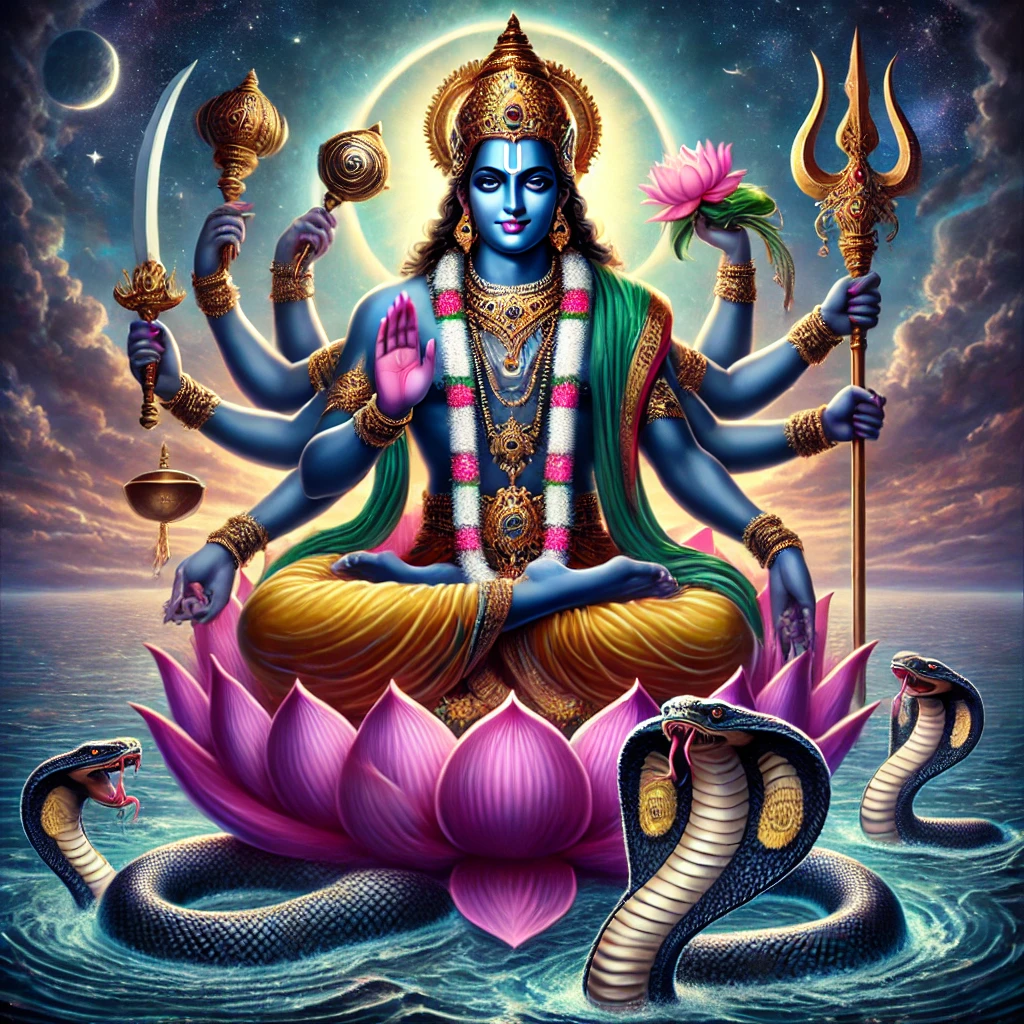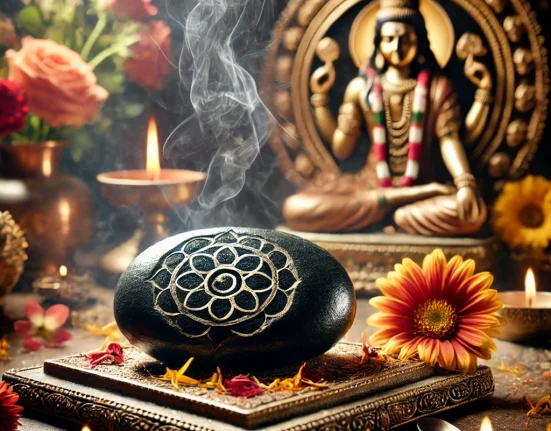Vishnu, a central deity in Hinduism, is revered as the “Preserver” or “Protector” of the universe. Along with Brahma, the creator, and Shiva, the destroyer, Vishnu forms the sacred trinity known as the Trimurti in Hinduism. Vishnu’s role in maintaining cosmic order has not only influenced Hindu beliefs but also found resonance in Buddhism and other spiritual traditions. For those interested in understanding Hinduism and Buddhism, Vishnu stands as a pivotal figure representing balance, protection, and harmony.
In this blog, we’ll explore who Vishnu is, his significance in various religious practices like pooja (rituals), the mantras dedicated to him, and how he is viewed across different belief systems. By diving into his mythology, characteristics, and role in maintaining the universe, you will gain a deeper understanding of this powerful deity.
The Origins of Vishnu
Vishnu’s origins can be traced to the Vedic period, where he is initially mentioned as a relatively minor deity. However, over time, Vishnu’s stature grew immensely, particularly with the rise of the Vaishnavism tradition, where he is worshipped as the supreme being. In Hindu scriptures such as the Bhagavad Gita and the Mahabharata, Vishnu’s role is often seen as the sustainer of all life, guiding the universe through cycles of creation, preservation, and destruction.
Why is Vishnu important in Hinduism?
In the Hindu worldview, life and the universe are cyclical, moving through periods of creation, maintenance, and destruction. Vishnu is responsible for the second stage—preservation—keeping the cosmos in balance. His divine interventions occur through his incarnations, known as avatars. These avatars descend to Earth to restore cosmic harmony whenever evil threatens to overpower good. Among his ten avatars, Rama and Krishna are the most well-known, each playing pivotal roles in Hindu epics.
The Role of Vishnu in Hindu Cosmology
To truly appreciate Vishnu’s significance, it’s essential to grasp his place in Hindu cosmology. According to Hindu belief, the universe undergoes a constant cycle of birth, growth, decay, and rebirth. Vishnu ensures the smooth functioning of this process. He is often depicted reclining on the cosmic serpent, Shesha, floating on the primordial ocean, symbolizing his eternal vigilance and readiness to act when necessary.
The Symbolism of Vishnu’s Iconography
Vishnu is typically portrayed with four arms, each holding a symbolic object:
- The Conch (Shankha) – representing the Om, the primordial sound of creation.
- The Discus (Chakra) – symbolizing the mind and the destruction of ignorance.
- The Mace (Gada) – signifying strength and power.
- The Lotus (Padma) – representing purity and spiritual enlightenment.
Each of these items embodies a core aspect of his personality as a protector and sustainer of the universe. His dark blue skin is symbolic of the infinite sky and ocean, further emphasizing his eternal and all-encompassing nature.
Vishnu’s Avatars: Restorers of Dharma
Perhaps what makes Vishnu unique in the pantheon of Hindu gods is his avatars, which descend to Earth whenever dharma (cosmic law and order) is at risk of being overshadowed by adharma (chaos and evil). The concept of avatars is deeply ingrained in Hindu belief and has profound significance in understanding Vishnu’s role.
The Ten Avatars (Dashavatara) of Vishnu:
- Matsya (the Fish) – Saves the Vedas from being lost during a great flood.
- Kurma (the Tortoise) – Helps retrieve lost treasures during the churning of the ocean.
- Varaha (the Boar) – Rescues the Earth from the demon Hiranyaksha.
- Narasimha (the Man-Lion) – Destroys the demon Hiranyakashipu to protect his devotee.
- Vamana (the Dwarf) – Subdues the demon king Bali by tricking him into giving up his power.
- Parashurama (the Warrior) – Eradicates corrupt and evil rulers.
- Rama (the King) – The protagonist of the Ramayana, an embodiment of righteousness.
- Krishna (the Cowherd) – The central figure in the Mahabharata, known for delivering the Bhagavad Gita.
- Buddha (the Enlightened One) – Sometimes regarded as an avatar, promoting non-violence and compassion.
- Kalki (the Warrior) – Yet to appear, Kalki will come at the end of the current era to restore balance.
Each of these incarnations demonstrates Vishnu’s ability to adapt to different challenges in maintaining the equilibrium of the universe. His avatars are not only revered in Hinduism but have also influenced other religious traditions such as Buddhism and Jainism.
Vishnu’s Role in Pooja and Mantras
In the day-to-day life of a devotee, Vishnu is worshipped through various poojas (rituals) and mantras. These practices not only venerate Vishnu but also align the devotee with his qualities of protection, guidance, and preservation.
The Importance of Pooja in Vishnu Worship
A typical Vishnu pooja involves offerings such as flowers, incense, and food, accompanied by the chanting of mantras. The act of performing pooja is a way of inviting the deity into one’s home or temple, establishing a personal connection with Vishnu’s divine energy. This connection is thought to bless the devotee with peace, prosperity, and spiritual growth.
Vishnu Mantras for Peace and Protection
Mantras dedicated to Vishnu are considered powerful tools for meditation, mental clarity, and spiritual growth. One of the most commonly chanted mantras is the Vishnu Sahasranama, which lists the thousand names of Vishnu, each highlighting a different attribute of his divine nature. Another popular mantra is the Om Namo Narayanaya, a simple yet profound chant that invokes Vishnu’s blessings and protection.
Devotees believe that reciting these mantras regularly not only brings Vishnu’s protection but also helps in achieving mental peace and emotional stability.
Vishnu in Buddhism: A Lesser-Known Connection
Interestingly, Vishnu’s influence extends beyond Hinduism. In certain forms of Buddhism, especially in Southeast Asia, Vishnu is recognized as a protector deity. While he doesn’t hold the same central role as in Hinduism, his presence in Buddhist cosmology underscores the interconnection between these spiritual traditions.
In regions such as Thailand and Cambodia, Vishnu has been depicted in ancient temple carvings, often shown in his avatar forms, particularly as Krishna or Rama. This highlights the syncretic relationship between Hinduism and Buddhism, where deities and mythologies overlap, enriching both traditions.
The Modern-Day Relevance of Vishnu
While Vishnu’s mythology dates back thousands of years, his teachings and values remain relevant today. In an age of uncertainty, people continue to seek balance and stability, both in their personal lives and the world at large. Vishnu’s role as the preserver resonates with modern spiritual seekers looking for guidance in maintaining harmony and order amidst chaos.
From a practical perspective, the values Vishnu represents—compassion, duty, and balance—are timeless. Whether it’s through the practice of daily pooja, the recitation of mantras, or simply reflecting on the lessons from his avatars, Vishnu offers a path of hope, courage, and perseverance.
Vishnu, the Eternal Protector
In conclusion, Vishnu’s role as the preserver of the universe makes him an indispensable figure in Hinduism, while his influence in Buddhism reflects the broader reach of his divine energy. Through his avatars, Vishnu steps into the world to restore balance, offering a beacon of hope and guidance. For modern devotees, Vishnu continues to be a source of strength, protection, and spiritual growth, whether through rituals like pooja, chanting his sacred mantras, or meditating on his universal qualities.
As we look at Vishnu’s enduring relevance, it becomes clear that he is much more than a mythological figure—he embodies a spiritual ideal that has transcended time and continues to offer wisdom for navigating life’s challenges.




Leave feedback about this